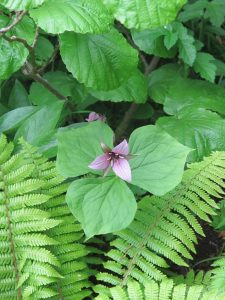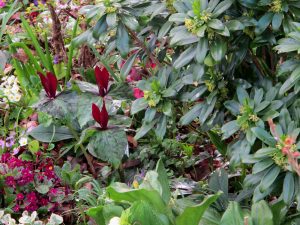I spend a great deal of time in my study. Many a time I sit there wishing I was in the garden instead of being tied to my screen, metaphorically speaking. However, when I get a whole day in the garden the weather sometimes lets me down. A few days ago, it lashed down for hours on end. I was picking leaves off my borders and cutting the foliage off my hellebores. Every bit of my clothing got soaked – and I do mean everything. For the first time ever, I found myself wishing that I was inside my warm study instead. That’s November for you! It’s the gloomiest month of all, full of tedious jobs like leaf picking.

The worst thing is, the unseasonably warm weather we’ve enjoyed (or not enjoyed) this year is working against us. The areas I weeded in October need doing again, because another crop of weeds have come up smiling, or should that be smirking! The leaves are just as annoying. Some of them are still glued to the branches, like Donald Trump’s hair in a gale. As I gaze upwards, through the torrential rain, I can see plenty of beech leaves fluttering above my cottage. Once upon a time, every leaf fell before the middle of November and that was it – over. This year’s leaf tidying will probably go on through December. Not a happy thought.
Some gardeners leave their leaves in situ but, if they stay on the ground here, tiny slugs tend to nibble my prized snowdrops and trilliums. So on I go, bent double or on my knees, picking or raking up leaves. Then I’m faced with the problem of where to put them! I have a wire bin for my leaves, but it’s still full of last year’s leaves. I can’t apply the leaf litter from that bin until I’ve collected this year’s leaves, so I’m having to resort to white builder’s bags, the sort aggregate comes in. They aren’t exactly beautiful to look at! I need two leaf bins, not one, I tell the Best Beloved. The usual pensive silence follows.

For the record, my collecting tool of choice is the silent rubber rake (from Bulldog Tools). Used lightly, it doesn’t damage plants as you rake through them, although certain delicate plants, such as Cyclamen coum, do need tidying with fingers if the buds are to be preserved. I don’t own, nor ever would, one of those ear-shattering leaf vacs. They should go in Room 101, along with those hedgehog and frog destroyers known as strimmers! Sadly, my neighbours love them!
Why do I bother to collect my leaves at all? Well, after a year or so, those damp soggy leaves turn into wonderful leafmould, the gardener’s equivalent of black gold. You can use this magic mix for seed sowing, mixed with equal parts of sharp sand. I prefer to add mine to the garden. It’s nowhere near enough to cover all of it sadly, so it goes round my prized hellebores, trilliums, erythroniums and hepaticas. It acts as a gentle feed and mulch. It looks good. And it is good. Although I do have to sieve out the beech nuts before I top dress the soil. Notice the word round though. Don’t mulch over the crowns of your plants: they really resent it. Some of them even die!
Some gardeners shred their leaves with the lawnmower and then compost them, because they rot down quicker. I’ve tried this, but most of my leaves come off beech trees and they resist the blades of the mower and emerge unscathed, flying into the air. Then I’m faced with collecting the blighters for the second time. I’m beginning to sound like British Rail, the wrong sort of leaves and all that. Perhaps I should start a grumpy garden blog. Oh, someone’s already got that covered. Perhaps, a grumpy woman’s blog then?
The type of leaf matters though. The RHS tell us that the best leaf litter is made from oak, beech and hornbeam leaves. They say that thick leaves, like sycamore, walnut, horse chestnut and sweet chestnut, should be shredded, before being adding to your leaf pile. I find oak, beech and hornbeam are thicker in texture than sycamore, walnut, horse chestnut and sweet chestnut. Horse chestnut and walnut leaves contain toxins, so I wouldn’t advise adding them at all. I wouldn’t add evergreen leaves, from holly, laurel or conifers, either. They take at least 3 years to rot down. Pine needles produce acidic leaf mould. Most of my gardening friends, with pine trees, leave it on the ground and underplant some acidic plants such as azaleas.

Whatever you do, don’t collect leaves from wild places. They form an important part of the ecosystem in woodlands and cemeteries, for instance. Don’t plonk them on the compost heap, because they’ll slow the decomposition process down because slower-acting fungi are involved in leaf decomposition. Compost heaps rely on faster acting fungi.
Fallen leaves contain variable amounts of a substance called lignin. This is the fibre in the leaf’s cell structure, and it’s slow to break down. Beech, birch, hornbeam, oak, sweet chestnut and magnolia leaves contain higher levels of lignin and lower levels of nitrogen and calcium. They are papery or leathery to the touch and they can take two years to rot down.
Ash, cherry, elm, linden, maple, poplar and willow leaves are lower in lignin, but higher in calcium and nitrogen, so they rot down faster. Like most gardeners I get a mix of leaves and they all get treated the same way. One handful could contain oak, sycamore, field maple and walnut, but most of my leaves are lignin-packed beech.
Dry, hot summers hinder the rotting process, because fungi thrive in damp conditions. It’s still worth doing though, because the organic material stays in the garden. It doesn’t go into landfill and that’s important for all garden waste. Try to put as much as you can on your compost heap, because this slow process takes place in an airy position.
Garden waste that gets put into landfill is covered up and then compacted. The green material rots down anaerobically, without the presence of oxygen. The material gets very hot, up to 60C, and then it emits lots of methane. The recycling charity WRAP tell us that “this dangerous greenhouse gas is 25 times more powerful than CO2, over a hundred-year period.” This fuels global warming.

The Landfill Directive is trying to reduce the amount of green material going into landfill in order to reduce the amount of harmful methane gas being released into the atmosphere. This is why green bins are being collected fortnightly, rather than weekly.
My secret weapon is an electric garden shredder and a pair of goggles. I invested in my silent shredder in 1995 and my model is no longer made. It’s still going strong and it’s about to shred my buddleia and the top growth from my roses. The shredder chops up the stems into sections, so they rot down far faster once they’re on the compost heap. Garden compost holds moisture and nutrients and it proved invaluable during the hot, dry summer. The vegetable beds that had a compost underneath the soil produced wonderful crops because the ground was fertile and moist.
I can see glimmers of hope, because snowdrops are nudging up and hellebore buds are forming. Roll on spring!



